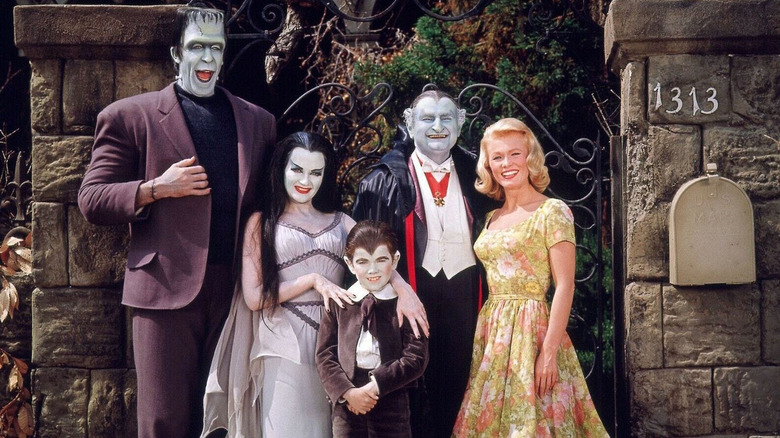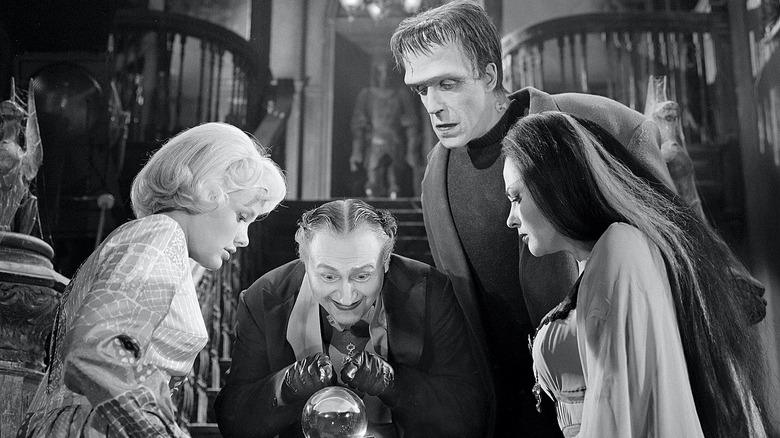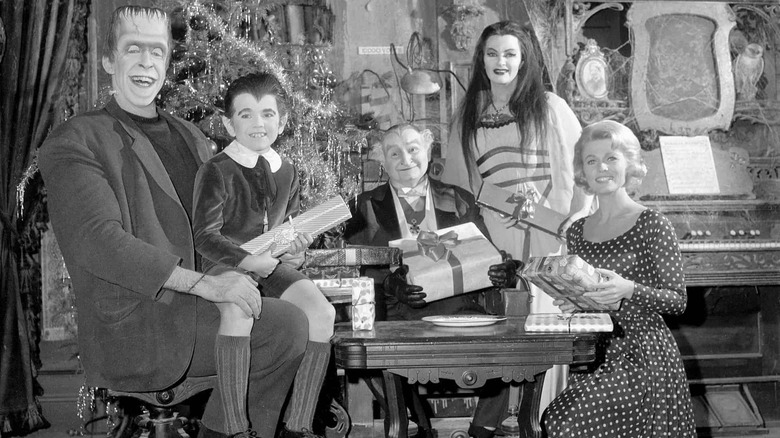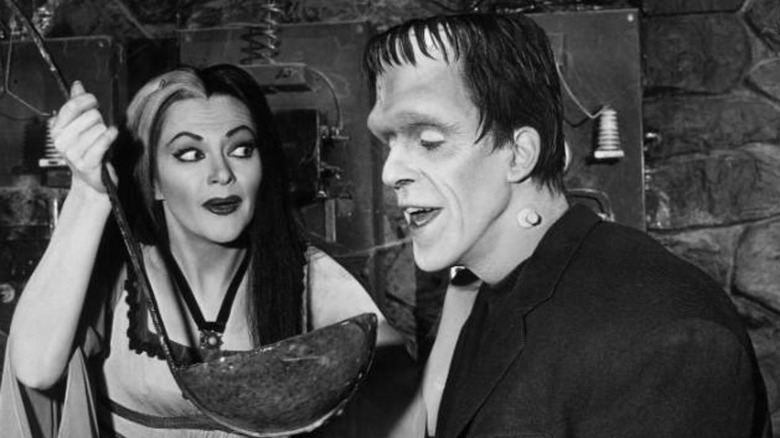Why The Munsters Are So Beloved
In the 1950s and early 1960s, American family sitcoms were all the rage. Shows like "Leave it to Beaver," "Father Knows Best," "Life with Blondie," and "The Andy Griffith Show" were wholesome looks at the idyllic, assimilated, white ways of American living, and dominated small screens across the country. Knowing that the cable stations couldn't survive off one type of family sitcom, writers started getting a little more creative. "Bewitched" took the typical formula of a married couple and incorporated the magic of witchcraft, as did the popular "I Dream of Jeannie." When it came time to revamp the family sitcom, creatives started tackling different worlds than that of the average suburban existence, like the fish-out-of-water series "The Beverly Hillbillies."
There were two short-lived shows, however, that took similarly massive creative swings by delivering family stories that were truly out of this world — "The Addams Family" and "The Munsters." Both shows highlighted families that reveled in the macabre, a juxtaposition to the popular squeaky-clean shows at the time.
"The Addams Family" was based on Charles Addams' cartoon strip of the same name, and has since been adapted into multiple live-action films, a cinematic animated reboot, video games, and even a Broadway musical. The constant revival of "The Addams Family" IP has kept it popular for decades. Meanwhile, decades later, "The Munsters" still has a dedicated fan base despite predominantly existing in the cultural vacuum of the 1960s.
Curious why "The Munsters" is still so beloved after all this time? Hop in the Drag-U-La and let this be your guide into the monstrous musings of "The Munsters."
The history of The Munsters
Produced by the creators of "Leave it to Beaver," the original series of "The Munsters" was a satirical look at the family sitcom, centered on a loving, kind family who just so happen to be monsters. The series starred Fred Gwynne as Herman Munster, depicted similarly to Frankenstein's monster, Yvonne De Carlo as Herman's vampire wife, Lily, Al Lewis as Lily's father, Grandpa, who resembles a geriatric version of Count Dracula, Butch Patrick as the Munster family's werewolf son, Eddie, and Beverley Owen (and later Pat Priest) as teenage niece Marilyn Munster, considered to be the "ugly duckling" of the family due to her conventional teen beach movie beauty.
"The Munsters" was not just a satire of family sitcoms, but also the tropes of classic monster movies and the hypocritical standards encouraged by "wholesome family value" television.
The series was nominated for a Golden Globe for Best Television Series but was unfortunately canceled after two seasons when its time slot on CBS ended up in direct competition with ABC's "Batman" with Adam West. "The Munsters" just couldn't compete against the celebrity cameo-filled caped crusader, but fortunately, "The Munsters" found new life in syndication.
Decades after the show's cancellation, "The Munsters" was revived in the 1990s after it aired on Nick at Nite and again in the 2000s when TV Land gave the freaky family at 1313 Mockingbird Lane a new home. It was perfect timing, as it allowed the kids who grew up watching "The Munsters" in the '60s to introduce the series to their own families.
The heart of The Munsters
It may be hard to believe given when it originally aired, but "The Munsters" was genuinely hilarious. In the pilot episode, Herman and Lily are invited to a masquerade party and Herman laments, "If there's anything that disturbs me, it's the idea of grown people like us dressing up in costume and looking ridiculous." The joke is an obvious reference to the monster costumes worn by the family, but in the world of "The Munsters," it's a testament to the authenticity of the characters.
The show's humor thrived in juxtaposition, a witty comedy of errors frequently bordering on farce. It was used as a vehicle to tackle taboo topics of the day like assimilation, integration, and civil rights, with the monstrous Munsters used as a stand-in for all marginalized members of society. But a big part of what made "The Munsters" so special was how its use of monsters allowed a variety of people to feel seen in a family sitcom for the first time. Monsters have been used as metaphors for "the other" since the dawn of horror cinema, and "The Munsters" made it so families that didn't resemble the Cleavers "Leave it to Beaver" could feel seen. The Munsters proved that you could look a little odd or unconventional to the general public, but still be a loving, supportive, accepting, and compassionate family. They allowed audiences of all ages to escape into a world where they could be as weird as they wanted, and would always have someone to love them exactly as they are.
A cultural juggernaut
While "The Munsters" hasn't been given the same pop-culture treatment as "The Addams Family," they've still remained present. Their Grammy-nominated theme song was sampled in the hit Fall Out Boy tune "Uma Thurman," there's a plethora of "Munsters" merchandise just a quick Google search away, and Rob Zombie's most popular and meme-able song, "Dragula," gets its name from the Drag-U-La drag racing car Grandpa makes in the episode "Hot Rod Herman."
In addition to the made-for-TV specials, there have been attempts to revive "The Munsters" multiple times over the years with the animated one-hour special "The Mini-Munsters," the sequel series "The Munsters Today," the reboot series "Mockingbird Lane" from "Hannibal" creator Bryan Fuller. However, with Rob Zombie's new movie "The Munsters" shaping up to be a faithful revisit of the grooviest ghoulies this side of Mockingbird Heights, the age of "The Munsters" supremacy may finally be upon us, nearly six decades after the show first arrived.
The original two seasons of "The Munsters" are currently available to stream on Peacock, and the show is just as brilliant as ever.



